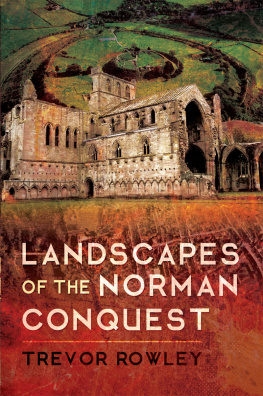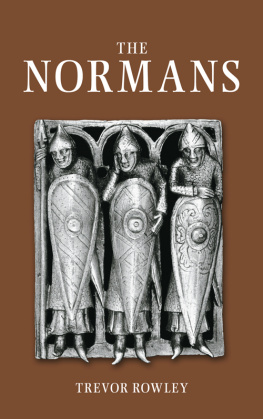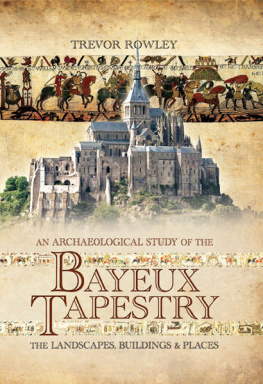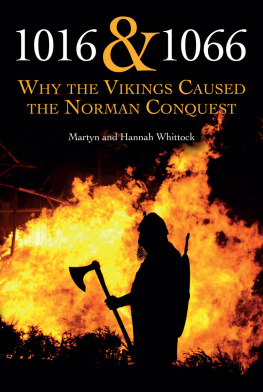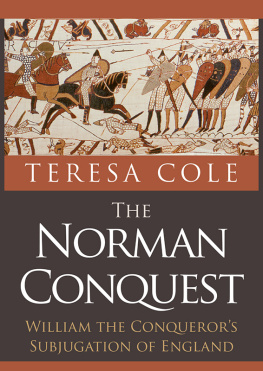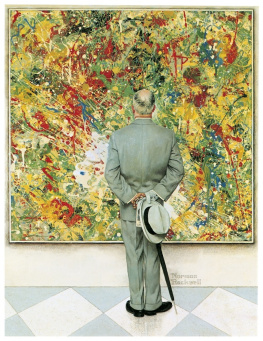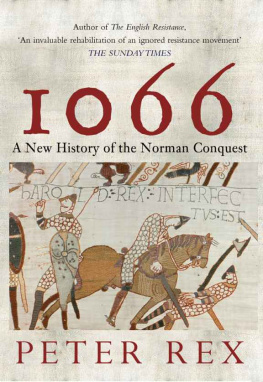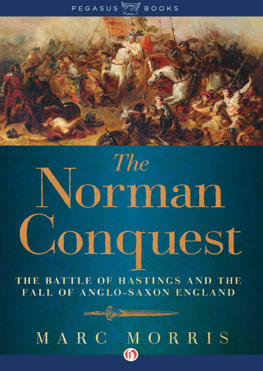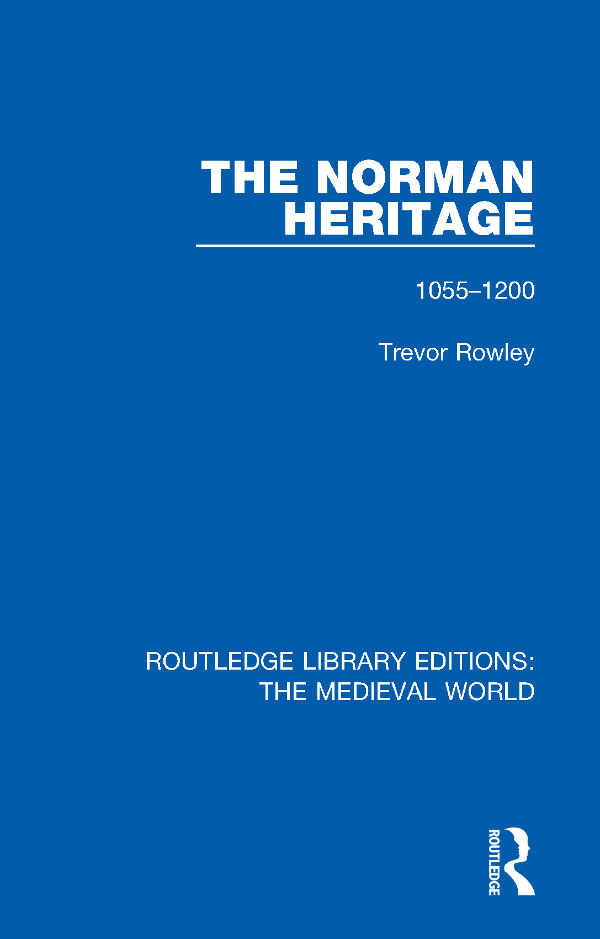
ROUTLEDGE LIBRARY EDITIONS: THE MEDIEVALWORLD
Volume 44
THE NORMAN HERITAGE
First published in 1983 by Book Club Associates
By Arrangement with Routledge & Kegan Paul plc
This edition first published in 2020
by Routledge
2 Park Square, Milton Park, Abingdon, Oxon OX14 4RN
and by Routledge
52 Vanderbilt Avenue, New York, NY 10017
Routledge is an imprint of the Taylor & Francis Group, an informa business
1983 Trevor Rowley
All rights reserved. No part of this book may be reprinted or reproduced or utilised in any form or by any electronic, mechanical, or other means, now known or hereafter invented, including photocopying and recording, or in any information storage or retrieval system, without permission in writing from the publishers.
Trademark notice: Product or corporate names may be trademarks or registered trademarks, and are used only for identification and explanation without intent to infringe.
British Library Cataloguing in Publication Data
A catalogue record for this book is available from the British Library
ISBN: 978-0-367-22090-7 (Set)
ISBN: 978-0-429-27322-3 (Set) (ebk)
ISBN: 978-0-367-18094-2 (Volume 44) (hbk)
ISBN: 978-0-429-05950-6 (Volume 44) (ebk)
Publishers Note
The publisher has gone to great lengths to ensure the quality of this reprint but points out that some imperfections in the original copies may be apparent.
Disclaimer
The publisher has made every effort to trace copyright holders and would welcome correspondence from those they have been unable to trace.
This edition published 1983 by
Book Club Associates
By arrangement with
Routledge & Kegan Paul pic
39 Store Street, London WC1E 7DD,
9 Park Street, Boston, Mass. 02108, USA,
296 Beaconsfield Parade, Middle Park,
Melbourne, 3206, Australia, and
Broadway House, Newtown Road,
Henley-on-Thames, Oxon RG9 1EN
Set in Linotron Palatino by
Rowland Phototypesetting Ltd,
Bury St Edmunds, Suffolk
and printed in Great Britain by
St Edmundsbury Press,
Bury St Edmunds, Suffolk
Trevor Rowley 1983
No part of this book may be reproduced in any form without permission from the publisher, except for the quotation of brief passages in criticism.
Library of Congress Cataloging in Publication Data
Rowley, Trevor, 1942
The Norman heritage, 10661200.
Bibliography: p.
Includes index.
1. Great Britain History Medieval period, 10661485.
2. England Historical geography.
3. Wales Historicalgeography.
I. Title.
DA176.R68 1982 942.02 82-18087
ISBN 0-7100-9413-2
Illustrations
Plates
The Figures
I would like to thank all those who have made the writing of this book possible, in particular Lucienne Walker for undertaking much of the background research and preparing plans and Melanie Steiner also for preparing plans. I have received advice from many colleagues on aspects of the Norman legacy and I would like to thank Professor L. Cantor in particular for permission to reproduce . I would also like to thank Shirley Hermon and Linda Rowley for the preparation of the typescript.
The author and publishers would like to thank the following for permission to reproduce illustrations: Phaidon Press, nos 2, 3, 7, 8 and 18; Bodleian Library, no. 50; the Trustees of the British Museum, no. 6; the Burrell Collection - Glasgow Museums and Art Galleries, no. 9; Cambridge Committee for Aerial Photography, nos 11, 12, 15, 16, 17, 26, 27, 28, 29, 30, 31, 32, 33, 34, 35, 37, 40, 41, 51, 52, 53, 54, 55, 56; National Monuments record, nos 4, 5, 13, 20, 22, 23, 24, 25, 43, 44, 46, 49; Oxfordshire Museums Service, no. 38; Public Records Office, no. 1. The remaining, uncre-dited, photographs are from the authors collection. Thanks are also due to the following for permission to reproduce the figures: P. Barker for .
To the archaeologist, the notion of material culture, of a society exemplified by its artefacts, is commonplace. To historians it has traditionally had less appeal, although Professor Fernand Braudels Civilisation matrielle et capitalisme marks a foray into unknown terrain. The intention of this series, which follows chronologically from another of more directly archaeological approach, is to see the history of Britain from the Norman Conquest to the Second World War, partly in human terms of changing cultural, social, political and economic patterns but more specifically in terms of what that society produced, and what remains of it today.
Few themes run with consistency through the history of the British Isles, save the land itself. This series seeks to show the way in which man has shaped and occupied the country, and how society has been moulded by the opportunities and constraints imposed by the landscape. The broad theme, is of mans interaction with his environment, which is carried through the series.
As editor, I have tried to allow each author to write his approach to the subject without undue interference. Ideally, such a study would have appeared as a large single volume but we have sought to make the divisions less arbitrary by allowing authors to cover a broad body of material in more than one book. Thus the volumes dealing with the medieval period come from the same hand, as do those spanning the sixteenth to the nineteenth centuries.
The effects of the Norman Conquest in England were pervasive, as Trevor Rowley makes clear early in his book, altering the whole framework of active life. The Conquest spawned a deep division in the way Englishmen regarded their past, some seeing in it a civilizing process, while others, like Tom Paine, writing in 1776 in Common Sense, looked upon it as the foundation of all our ills: French bastard landing with an armed banditti and establishing himself King of England, against the consent of the natives, is, in plain terms, a very paltry, rascally original. The basis for a rational judgment of the effects of the Conquest is more difficult to formulate, since so much of the documentary evidence is fragmentary or ambiguous. Thus the importance of the type of analysis made by Trevor Rowley of the landscape and material features often provides the only certain basis which we possess for understanding many aspects of our Norman heritage.
The achievement of the Normans becomes all the more remarkable given the relative brevity of the Norman period. In two generations the throne had passed to the first of the Plantagenets, Henry of Anjou, with little of the Norman in him either by blood or upbringing. Moreover, the first years after the Conquest were dominated by consolidation, and defence against Saxon revolt. The surge of building, of administrative and social reconstruction, and the extension of Norman power on the periphery, into Wales and Scotland, was concentrated into a short timespan under the Conqueror himself and his only English-born son, Henry I. The ferocious energy displayed by the Normans, not only in the British Isles but in all their domains, was the key to their success.
Andrew Wheatcroft
Britain before the Conquest, 5 vols, Routledge & Kegan Paul, 1979-81.
To Richard and Susannah
Next page

